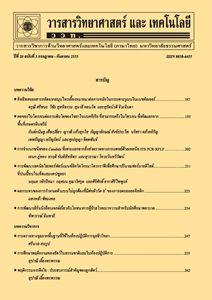การประเมินความต้านทานต่อเพลี้ยกระโดดหลังขาวในพันธุ์ข้าวไทยที่ระยะการเจริญเติบโตต่างๆ
Main Article Content
บทคัดย่อ
บทคัดย่อ
ศักยภาพความต้านทานต่อแมลงศัตรูพืชอย่างเพลี้ยกระโดดหลังขาว (WBPH; Sogatella furcifera) นั้นถูกควบคุมด้วยปัจจัยหลัก 3 ปัจจัย ได้แก่พันธุกรรมพืช การปรับตัวของแมลง และสภาพแวดล้อม การประเมินความสามารถในการต้านทานต่อเพลี้ยกระโดดหลังขาวในสภาพวะปัจจุบันจะทำให้ได้ข้อมูลที่เป็นประโยชน์ต่อเกษตรกรและนักปรับปรุงพันธุ์ข้าวต่อไป งานวิจัยนี้ใช้พันธุ์ข้าวไทยจำนวน 6 พันธุ์ ร่วมกับพันธุ์ทดสอบต้านทานราตูฮิเนติ และทดสอบมาตรฐานอ่อนแอไทชุงเนทีพ1 วางแผนการทดลองแบบสุ่มสมบูรณ์จำนวน 5 ซ้ำ โดยใช้เพลี้ยกระโดดหลังขาวที่เก็บรวบรวมจากศูนย์วิจัยข้าวจังหวัดพิษณุโลก การทดสอบที่ระยะกล้าโดยวิธี Standard seed box screening โดยใช้ตัวอ่อนเพลี้ยกระโดดหลังขาววัยที่ 2-3 จำนวนเฉลี่ย 10 ตัวต่อต้นในสภาพโรงเรือนทดลอง การทดสอบที่ระยะแตกกอเต็มที่ และระยะกำเนิดช่อดอกจะทำการทดสอบเมื่อต้นข้าวมีอายุ 45 และ 75 วัน ตามลำดับ การทดลองที่ระยะแตกกอเต็มและระยะกำเนิดช่อดอกโดยการปล่อยที่ตัวอ่อนเพลี้ยกระโดดหลังขาวที่ระยะ 5 จำนวน 10 ตัวต่อต้น ผลการทดสอบพบว่า ในทุกระยะการเจริญเติบโต ข้าวแต่ละพันธุ์แสดงระดับความต้านทานแตกต่างกันอย่างมีนัยสำคัญทางสถิติ ในบรรดาพันธุ์ข้าวทดสอบพบว่า ไม่มีข้าวพันธุ์ใดเลยที่แสดงความต้านทานต่อเพลี้ยกระโดดหลังขาวในระดับต้านทานสูงในทุกระยะการเจริญเติบโต เมื่อบันทึกผลที่ระยะ 14 วัน หลังจากการปล่อยแมลง ข้าวทั้ง 6 พันธุ์แสดงความต้านทานในระดับต้านทานปานกลาง และต้านทาน ที่ระยะกำเนิดช่อดอก ซึ่งมีความต้านทานมากกว่าการเจริญเติบโตของต้นข้าวที่ระยะอื่นๆ
Article Details
References
Ramesh, K., Padmavathi, G., Deen, R., Pandey, M.K., Lakshmi, V.J. and Bentur, J.S., 2014, Whitebacked planthopper Sogatella furcifera (Horva´th) (Homoptera: Delpha cidae) resistance in rice variety Sinna Sivappu, Euphytica 200: 139-148.
Khush, G.S., 1984, Breeding for resistance to insects, J. Environ. Prot. Ecol. 7: 147-165.
Renganayaki, K., Allan, K.F., Sadasivam, S., Pammi, S., Harrington, S.E., McCouch, S.R., Kumar, S.M. and Reddy, A.S., 2002, Mapping and progress toward map-based cloning of brown planthopper biotype-4 resistance gene introgressed from Oryza officinalis into cultivated rice, O. sativa, Crop Sci. 42: 2112-2117.
Yamasaki, M., Yoshimura, A. and Yasui, H., 2003, Genetic basis of ovicidal response to whitebacked planthopper (Sogatella furcifera Horvath) in rice (Oryza sativa L.), Mol. Breed. 12: 133-143.
Zhai, B.P., Zhou, G.H., Tao, X.R., Chen, X. and Shen, H.M., 2011, Macroscopic patterns and microscopic mechanisms of the outbreak of rice planthoppers and epidemic SRBSDV, Chin. J. Appl. Entomol. 48: 480-487.
Tang, M., Hao, P., Yang, Z., Zhu, L. and He, G., 1994, Penetration into rice tissues by brown planthopper and fine structure of the salivary sheaths, Entomol. Exp. Appl. 129: 295-307.
Tao, C.H. and Nooan, N.L.D., 1970, An ecological study of white-back plant hopper, Sogatella furcifera Horvath in Vietnam, 1968, J. Taiwan Agric. Res. 19(4): 82-89
Khan, Z.R. and Saxena, R.C., 1985, Behavioral and physiological responses of Sogatella furcifera (Homoptera: Delphaci dae) to selected resistant and susceptible rice cultivars, J. Econ. Entomol. 78: 1280-1286.
Jairin, J., Teangdeerith, S., Leelagud, P., Kothcharerk, J., Sansen, K., Yi, M., Vanavivhit, A. and Toojinda, T., 2009, Development of rice introgression lines with brown planthopper resistance and KDML105 grain quality characteristics through marker-assisted selection, Field Crops Res. 110: 187-207.
Tan, G.X., Weng, Q.M., Ren, X., Huang, Z., Zhu, L.L. and He, G.C., 2004, Two whitebacked planthopper resistance genes in rice share the same loci with those for brown planthopper resistance, Heredity 92: 212-217.
IRRI, 2013, Standard Evaluation System (SES) for Rice, 5th Ed., International Rice Research Institute, Manila, 29 p.
R Core Team, 2020, R: A Language and Environment for Statistical Computing, R Foundation for Statistical Computing, Vienna, Austria, Available Source: https://www.R-project.org, October 15, 2020.
Yamasaki, M., Tsunematsu, H., Yoshimura, A., Iwata, N. and Yasui, H., 1999, Quantitative trait locus mapping of ovicidal response in rice (Oryza sativa L.) against whitebacked planthopper (Sogatella furcifera Horvath), Crop Sci. 39: 1178-1183.
Kimkhow, S., Pongprasert, W., Buranapanichpan, S., Kulsarin, J. and Chanbang, Y., 2013, Reactions of BC4F3-4 rice lines (Rathu Heenati/KDML105 x Chai Nat 1) on white-backed planthopper in lower Northern Thailand, J. Agric. 29(1): 45-54. (in Thai)
Heinrichs, E.A., 1986, Prospectives and directions for the continued development of insect-resistant rice varieties, Agric. Ecosyst. Environ. 18: 9-36.
Bosque-Perez, N.A. and Buddenhagen, I.W., 1992, The Development of Host-Plant Resistance to Insect Pests: Outlook for the Tropics, pp. 235-249, In Menken, S.B.J., Visser, J.H. and Harrewijn, P. (Eds.), Proceedings of 8th International Symposium on insect-plant relationships, Kluwer Academic Publishers, Dordrecht.
Tanaka, K. and Matsumura, M., 2000, Development of virulence to resistant rice varieties in the brown planthopper, Nilaparvata lugens (Homoptera: Delpha cidae), immigrating into Japan, Appl. Entomol. Zool. 35: 529-533.
Savary, S., Horgan, F., Willocquet, L. and Heong, K.L., 2012, A review of principles for sustainable pest management in rice, Crop Protect. 32: 54-63.
Mackill, D.J., Ismai, A.M., Pamplona, A.M., Sanchez, D.L., Carandang, J.J. and Septininghih, E.M., 2010, Stress tolerant rice varieties for adaptation to a changing climate, Crop, Environ. Bioinform. 7: 250-259.

